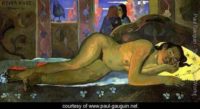Gauguin’s erotic Tahiti idyll exposed as a sham.
Paul Gauguin, renowned for his paintings of exotic idylls and Polynesian beauties, was a sadist who battered his wife, exploited his friends and lied to the world about the erotic Eden he claimed to have discovered on the South Sea island of Tahiti.
The most exhaustive study ever of Gauguin’s life has revealed a brutal man who falsely cast himself as a creature of exotic sexuality, a defender of women’s rights and a bastion of socialist ideals.
‘No one has ever questioned Gauguin’s own version of the man he was and the life he lived,’ said Nancy Mowll Mathews, author of Paul Gauguin, An Erotic Life, to be published this week. ‘But the reality couldn’t be more different.’
Until now, the received opinion has been that Gauguin’s wife was a bullying harridan who chased her husband from the family home. But Mathews has discovered letters that prove that Matte Gad was in fact a kind, clever woman who was victimized physically, verbally and emotionally by her husband.
‘When I was 10 years old,’ the couple’s son, Emil, wrote in a previously unpublished letter, ‘I saw my father bloody my mother’s face with his fist.’
By 1890, Gauguin’s career was in crisis: Matte had forced him from the family home, his paintings were out of favor and he had been dropped by the city’s best art dealers. ‘By the end of the year, Gauguin was like a cornered dog,’ said Mathews. ‘He was harrying friends for cash and desperately proposing one new money-making scheme after another.’
Eventually, in 1891, he hit on the idea of traveling to Tahiti to paint illustrations for the most popular novel of the day, Pierre Loti’s The Marriage of Loti . He held a banquet for the cream of the literary and artistic world and explained how the primitive, erotic living conditions on Tahiti would revive his muse.
‘He portrayed the natives as living only to sing and to make love,’ said Mathews. That’s how he got the money from his friends and raised the public’s interest in his adventure. But, of course, he knew the truth, which was that Tahiti was an unremarkable island with an international, westernized community.’
‘I stand at the edge of the abyss, yet I do not fall in,’ Gauguin wrote to a friend on the eve of his departure.
Tahiti was more sexually liberated than turn-of-the-century Paris and there is no doubt that Gauguin reveled in the opportunities it offered, but his time there was not nearly as extreme as he claimed. Unfazed, Gauguin transformed his prosaic experiences into titillating erotic adventures.
‘The island [and the realities of Gauguin’s life there] are virtually unrecognizable in his representations, carefully calculated to intrigue the French audience,’ said Mathews.
After two years, Gauguin returned to France, expecting a hero’s welcome. But what should have been a triumphant return turned into a morass of misunderstanding and disappointment as his paintings remained unsold.
In a final attempt to spark the public’s interest, Gauguin wrote Noa Noa, his autobiographical account of his life in Tahiti. ‘Writing the book was the beginning of Gauguin’s writing of an erotic life for himself,’ said Mathews. ‘He created a life for public consumption as part of his campaign to make his exhibitions – and therefore his future – a success.
Gauguin’s efforts failed, however, and less than a year later, he was making plans to return to Tahiti. ‘Gauguin seems to have fallen for the myth of Tahiti he created,’ said Mathews. ‘He returned expecting the erotic idyll that was only ever a figment of his imagination. Of course, he didn’t find it and the disappointment was profound: he died a twisted and bitter man, having alienated everyone both at home and in Tahiti. It’s a sad story of a man who believed his own fiction.’
(Amelia Hill — a senior reporter for the Guardian)



Administrator’s Note:
While articles are being added to this newly developed News section, public commentary is switched off. If you wish to comment please proceed to Facebook: HMS Bounty – Conspiracy on the Bounty where you will locate an identical or verisimilar article.
See: https://web.facebook.com/HMS-Bounty-Conspiracy-on-the-Bounty-328458497262836/